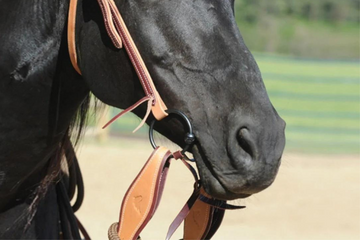Bits for Horses: A Complete, Natural Guide
bij Parelli Natural Horsemanship op Feb 28, 2024

How Do Horse Bits Work?
One of the important pieces of equipment for a horseback rider is the bridle and bit. It is one of the ways a rider communicates with her horse. Hackamores can also be a great choice for many horses and humans, but today we will focus specifically on bits – what they are, why we use them, and a few of the different types available today.
A bit is a piece of metal that is placed in the horse's mouth and attaches to the bridle and reins. When a rider applies pressure to the reins, the pressure is translated to the horse's mouth by the bridle and bit.
There are a myriad of different types of bits, each with a unique design and purpose. Overall, bits can be categorized on the gentle side or the harsh side. The “correct” bit can vary for different horses based on their level of experience and even their Horsenality.
In addition, riders must educate themselves to use a bit correctly. Even the most gentle bit in inexperienced hands or if used improperly can cause pain and damage a horse's mouth.
Types of Bits
Bit Material
Horse bits are designed out of a variety of materials. We do our best to choose materials that are not offensive to horses. The common choices are stainless steel, copper, sweet iron, rubber, and titanium. These materials prompt a horse to salivate, keeping their mouth comfortable and supple.
Bit Size
Bit sizes vary to accommodate horses of different sizes and needs. A bit that is too small for a horse will pinch and cause discomfort. On the other hand, a bit that is too big will slide around in the horse's mouth, causing poor communication between rider and horse.
You will also need to consider the horse’s training and preferences.
How Do I Choose the Right Bit for My Horse?
Horse’s Experience Level
The horse’s training level is one of the most important things to consider when choosing a bit. Young and inexperienced horses will benefit from a bit that provides clear, direct communication. However, well-developed horses can benefit from a more advanced bit, designed for refinement.
Riding Discipline
Riders of different disciplines may prefer different bit styles. What you observe in a dressage arena will differ from western sports such as reining which will also differ from what the average rider uses on the trail. Be sure you research the appropriate and legal bit options for your riding discipline, and of course speak to your Licensed Parelli Professional for more guidance specific to you and your horse.
Snaffle Bits
Snaffle bits are a very common bit used in both English and Western riding. These bits have a 1:1 leverage ratio of pressure meaning the amount of pressure applied by the rider is the amount of pressure the horse receives. They come in a variety of mouthpieces and rings, and are usually a good choice for starting young horses as well as foundation training.
Loose Ring, Single Joint Snaffles
The Parelli Program recommends single-jointed snaffle bits for most horse and rider combos when they are starting out. A loose ring snaffle means the bit can slide and move in the rings allowing the horse some freedom to position it as he desires, and the jointed mouthpiece enables a rider to use neutral lateral flexion to bend a horse’s head and neck to each side for safety and control. The Parelli single jointed snaffle bit is made of sweet iron with copper inlays so it is as palatable as possible for horses.
Leverage Bits
Leverage bits are traditionally used in Western riding although you will also see some English riders with them as well. It’s important to note that leverage bits multiply the pressure the horse receives from the bit. So, for example, if a rider exerts one pound of pressure on the horse’s mouth, depending on the length of the shank of the leverage bit, the horse will receive a multiplication of that pressure. In general, the shorter the shake, the more mild the bit.
Ported Curb Bit
The ported curb bit utilizes a curved mouthpiece with a raised port. Overall, the ported curb bit is gentler on the horse's tongue by providing tongue relief and can give extra comfort to a horse with a sensitive tongue. The ported curb bit is still leveraged so it will increase pressure from the rider’s hands to the horse’s mouth.
Advanced Horse Bits
Spoon and Spade Bits
Spoon and spade bits are advanced bits reserved for highly trained horses taken from the Vaquero style of western horsemanship for developing finished bridle horses. Each bit has its own unique mouthpiece and many are quite decorative works of art.
Pelhams or Double Bridles
Advanced English riders often choose pelhams or double bridles. These bridles consist of a snaffle and a curb bit allowing the rider to communicate in different ways through the two bits.
You now have a big picture view of what bits are, why they are used and a few of the different types out there. There are almost as many different types of bits and headgear for horses as there are different colors and markings, but not all are designed with the horse in mind. Remember, a bit is a communication tool. Yes, at times we use it for control, but it’s also one of many ways we build a language with our horses.
Pat Parelli often says you can tell a horseman by the tools he uses and also by the tools he will not use. Seek the advice of a Parelli Professional, and of course check out our available bits and bridles for a great selection of tools designed for clear communication and comfort for both rider and horse.







